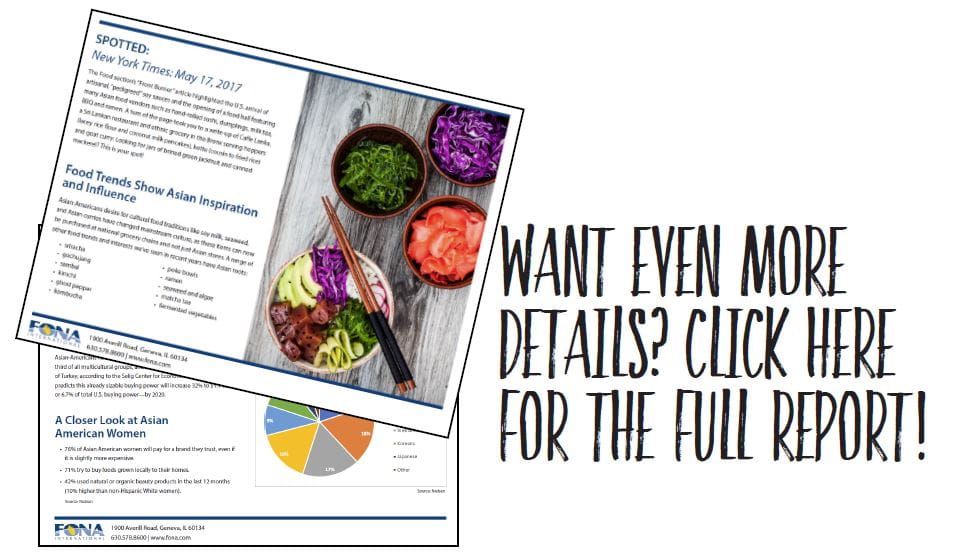Asian Consumers: Health Focused with Major Buying Power
July 3, 2017
They’re the nation’s fastest growing population segment, and just so happen to have a combined buying power of many countries’ economies. Asian Americans tend to be educated, affluent, health-minded and often use food as a pathway to wellness. They also lead the way with many product innovation, whether it be a new unique flavor or leading the way onorganic purchases. But is this segment getting overshadowed? The food industry is often focused on capturing the interest of other populations, particularly Hispanic Millennials. Yet Asian Americans are certainly another buying force worth courting.
Let’s take a look at the Asian American segment, especially their interests and influence when it comes to food and flavor trends.

A Growing Demographic
While the U.S. Hispanic population is three times larger than the Asian American community, the Asian American population is growing at a faster rate, reports The Atlantic. There are about 20.5 million Asian Americans, representing a 25% population increase from 2009-2014. U.S. Census projections predict this segment grow to 25.7 million by 2019, eventually outnumbering Hispanics by 2055.
Buying Power
Asian-Americans have $825 billion in spending power. This ranks them third of all multicultural groups, and also places them just above the GDP of Turkey, according to the Selig Center for Economic Growth. And Nielsen predicts this already sizable buying power will increase 32% to $1.1 trillion–or 6.7% of total U.S. buying power—by 2020.
A Closer Look at Asian-American Women
• 76% of Asian American women will pay for a brand they trust, even if it is slightly more expensive.
• 71% try to buy foods grown locally to their homes.
• 42% used natural or organic beauty products in the last 12 months (10% higher than non-Hispanic White women).

Diversity of Asian Americans
Know your customers! When product developers think of the Asian market, it’s important to realize it isn’t a single group. Asians in America come from more than 40 different countries (like India, China, Vietnam, Korea, and the Philippines), representing a wide variety of cultures, languages, and food preferences. Jeffrey Humphreys, director of the Selig Center, says this is a large challenge for brands looking to connect with them. Unlike Latinos, he explains, Asian Americans don’t basically share a single language. “These are very, very different cultures, with different languages, so it makes it quite hard to deliver a culturally sensitive message,” says Humphreys.
Tradition and a Healthful Mindset Drive Grocery Purchases
Tradition
The dinner table plays a significant role across cultures in America, but it is the leading cultural connector for Asian Americans, linking them with their heritage and traditions. Half of Asian Americans connect to their culture through cooking or eating. (A number that is 23% higher than reflected in the total U.S. population.) And roughly the same number report connecting to culture through family. So, meal times, and family meal times in particular, are of great importance to Asians in America today.

Health & Wellness
Asian Americans are health-conscious consumers who often believe food is the pathway to health and beauty. In fact, they are the most health-minded segment of all U.S. consumers, indexing higher than average across a broad spectrum of healthy lifestyle practices. Nielsen’s latest report on Asian American consumers states that these factors result in a relatively similar traditional diet, consisting largely of rice, vegetables and fruits, with the main proteins of fish, pork, tofu, poultry, nuts, and dry beans.
Organic: The desire for health through food leads Asian Americans to be large consumers of organic foods. They equate organic as healthier, and purchase organic foods at a rate 52% higher than the total population. Specifically, 50% of Asian American women, who as a demographic prioritize healthy lifestyles through food, regularly eat organic food.
Vegetable-Focused: Significantly, nearly one fifth (19%) of Asian consumers report being vegetarian, versus just 7% of all consumers. At least 25% report looking for vegetarian protein sources, compared to 15% of White Non-Hispanic consumers.
A real-life example of these vegetarian percentages is Public School 244, located in Queens, New York. It’s the nation’s first non-charter public school to serve only vegetarian meals. The idea to go meatless came about when teachers noticed that most of the children, 86% of whom are Asian, were bringing vegetarian food in their lunch boxes. The school now serves meals such as jasmine rice, three-bean chili and steamed plantains, with an apple and oatmeal raisin cookie.

U.S. Consumers as a Whole Also Looking for Authenticity in Asian Cuisines
People of all backgrounds and cultures are searching for authentic food experiences, and the rise of foodie culture and social media have helped spread ideas far and wide. “As we become more educated, more understanding of each other, and more invested in traditional culture, we’ve begun to demand more authenticity in our food,” says Constantine Spyrou of Food Beast.
“When it comes to taste profiles, consumers really do have an appetite for authenticity,” says Sascha Thaens, Director Sales Management & Strategy, RAPS GmbH & Co. KG, a leading European ingredient company. “Asia, America, Africa – globalization in every area of life has made today’s consumers connoisseurs and experts in all kinds of international cuisines,” he continues. “Because they themselves travel the world, it’s not really surprising that demand for authentic products and special ingredients from other culinary cultures has become a recognizable trend.”
Food Ingredients First reports seeing this wave of authenticity in New York City’s Tim Ho Wan restaurant, which brought “Hong Kong’s most famous dim sum” to the U.S., and in a huge increase in demand for authentic Japanese food like Hiroshima-style Okonomiyaki. Okonomiyaki is a savory, stacked pancake dish recently described as “Japanese soul food” in a Toronto Life article that proclaimed the dish would “change everything you thought you knew about pancakes.”
Almost half of Forbes’ recap of 2016’s hottest food trends were Asian inspired: Asian Twists on Comfort Food, Filipino Cuisine, Miso and Turmeric. A high level of Asian influence can also be found on Eater’s list of 8 Dining Trends That Will Define 2017. They call out:
Chawanmushi: A regular on Japanese restaurant menus, chawanmushi is a savory egg custard set with soup stock rather than milk or cream. It’s traditionally filled with shrimp or meat, but its simplicity makes it an interesting canvas for adventurous chefs and diners alike. Bill Addison of Eater tried it filled with caviar and cauliflower mushrooms at the South Philly restaurant Serpico and trout roe, crab, okra, and radish at Mosu near San Francisco’s Japantown.
Crab Rangoon:The “current dumpling darling” may be a familiar menu item, but it’s getting make-overs at restaurants like Olmsted in Brooklyn where it’s filled with kale and Washington D.C.’s TenPenh where the dumpling has been turned into a dip with wonton chips.

Food Trends Show Asian Inspiration and Influence
Asian-Americans desire for cultural food traditions like soy milk, seaweed, and Asian curries have changed mainstream culture, as these items can now be purchased at national grocery chains and not just Asian stores. A range of other food trends and interests we’ve seen in recent years have Asian roots: sriracha, kimchi, kombucha, poke bowls, ramen, matcha, and many more.
Consumers Worth Connecting With
Asian Americans’ rising population, affluence and strong connection to food and meal time make them an important demographic for product developers and marketers. The extremely varied heritage and preferences represented by these consumers means messaging and flavor choices should be bold and inclusive. While successfully appealing to such a diverse segment might be a balancing act, it presents incredible opportunity. These consumers are interested in flavor and ingredient innovation and authentic ethnic dining experiences, in addition to holding $825 billion in spending power. Developing food, beverage and healthcare products with this segment in mind may prove a worthwhile investment.

FONA CAN HELP!
Let FONA’s market insight and research experts translate these trends into product category ideas for your brand. They can help you with concept and flavor pipeline development, ideation, consumer studies and white space analysis to pinpoint opportunities in the market. Our flavor and product development experts are also at your service to help meet the labeling and flavor profile needs for your products to capitalize on this consumer trend. We understand how to mesh the complexities of flavor with your brand development, technical requirements and regulatory needs to deliver a complete taste solution.
CONTACT OUR SALES SERVICE DEPARTMENT at 630.578.8600 to request a flavor sample or visit www.mccormickfona.com.
Sources: Nielsen, The Atlantic, Eater, Packaged Facts, Columbia Graduate School of Journalism, Mintel, Forbes, Toronto Life.



